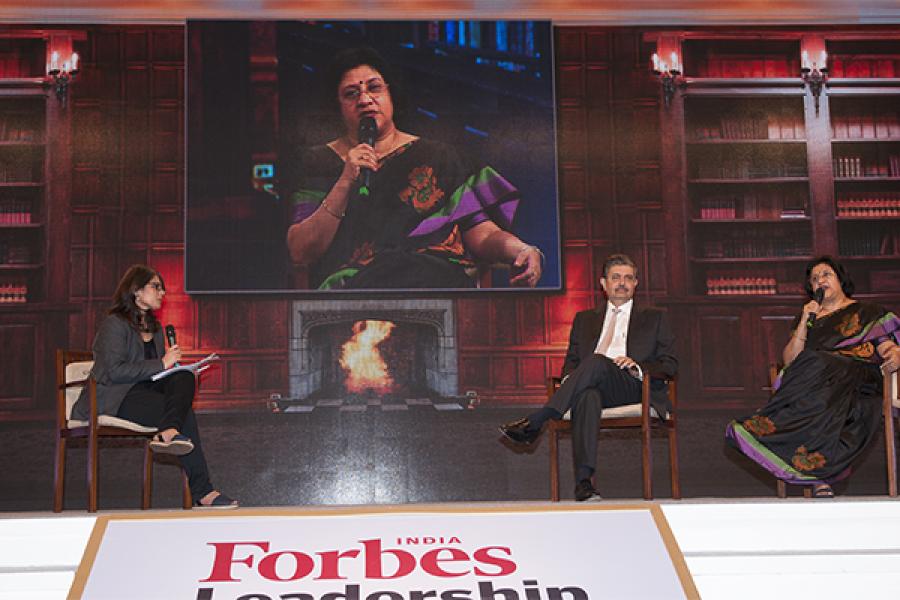
India a good boy in a bad world: Uday Kotak
The nation is following a disciplined monetary path that will pay off in the long run, says Kotak Mahindra Bank chief
One of India’s top bankers, Kotak Mahindra Bank’s executive vice chairman and managing director Uday Kotak, visualises India as the “good boy in a bad world”. Speaking at the Forbes India Leadership Awards 2015, Kotak said with India’s current account and fiscal deficit data improving over the past year and the country adopting a conservative monetary policy, it has been more “disciplined” than several other economies.
“Some countries have loose monetary and fiscal policies and they are getting away with it. India is following a much more disciplined approach, so then [recovery] will take longer,” he said. “But the good news about being a good boy is that in the long-run India will be better off,” he said.
Kotak and the State Bank of India chairman Arundhati Bhattacharya spoke to CNBC-TV18’s executive editor Menaka Doshi at a fireside chat at the awards on Wednesday night. Kotak won the Entrepreneur for the Year award while Bhattacharya was selected as the best CEO of a public sector organisation.
Both bankers spoke on a range of issues from the disruptive impact of technology on traditional banking, the biggest challenges they faced and how quickly India’s economy will start to turn around.
The rapid changes in banking through digitisation were very much the focus for Uday Kotak. “I wake up every morning wondering whether if I will have a bank. That is the level of change and opportunity [we are witnessing],” Kotak said. He spoke about the 80:20 philosophy of banking. “We had learnt that 20 percent of the customers make [provide] for 80 percent of the money. But in the new age, 80 percent of customers, which is the long tail, gets you the money,” Kotak says. The only aspect of new technology which banks have to deal with is security and privacy, he added.
Bhattacharya felt that banking for SBI, through the traditional branch networks would survive for the next five to 10 years. “If you asked me about the next 25 to 30 years, I would be less certain.” She said there was a vast population who wanted the ‘touch and feel’ experience while banking, while the youth were comfortable banking through a screen. But India, she said, was lucky as its banking pie is still expanding. “It is not the question of the pie size remaining same and people wanting bigger slices amongst themselves,” she told the gathering.
With the government and the Reserve Bank of India’s thrust to drive financial inclusion, the country is witnessing the entry of two new universal banks, IDFC and Bandhan. Clearances have been given to set up 11 new payment banks and 10 small finance banks—all in the space of the past two months.
“We would like to offer our services to Ujjivan in what they are doing,” Bhattacharya added. Ujjivan Financial Services in September got an in-principle approval from the RBI to set up a small finance bank. “Today we [SBI] have the technology, communication vendors and a scalable model to create a franchise network. So much of India is not banked and technology is allowing us to bring them into the banking world,” said Bhattacharya.
When asked about how much longer Indian banks would take to ride out of a tough business cycle, Bhattacharya said the banking sector could see improved credit growth and lower non-performing assets (NPAs) after four more quarters.
Uday Kotak, who has in several media interactions, said the government line that “achhe din” [good days] would come soon, was clear that good days had come for savers but not borrowers. “We have to ask achhe din for whom? Achhe din has come for savers not necessarily for borrowers,” Kotak said.
Kotak complimented the RBI governor Raghuram Rajan, who on Tuesday had announced a larger than expected 50 basis points cut in the repo—the rate at which the RBI lends to commercial banks—to 6.75 percent. This move was widely cheered by the business community and the stock markets then. With the rate cut, Kotak said the “shoe was back” on banks, the government and the business lobby to take necessary steps, to aid a revival in the economy.
















